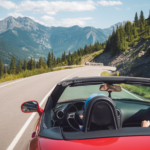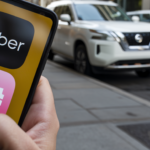Learn how to maximize fuel efficiency on long road trips with expert tips on driving habits, vehicle maintenance, and smart route planning.
Long road trips can be an exciting adventure, but fuel costs can quickly add up, especially with fluctuating gas prices. Whether you’re driving cross-country or just heading out for a weekend getaway, maximizing fuel efficiency will save you money and help reduce your carbon footprint.
Follow these expert fuel-saving tips to get the most out of every gallon on your next long drive!
1. Drive Smoothly and Avoid Aggressive Driving
Your driving style has a huge impact on fuel economy. Aggressive behaviors like rapid acceleration, hard braking, and excessive speeding waste gas and lower your mileage.
How to Drive Efficiently:
✔ Accelerate gradually instead of flooring the gas pedal.
✔ Maintain a steady speed whenever possible.
✔ Coast to a stop instead of braking hard.
✔ Use cruise control on highways to optimize fuel usage.
Pro Tip:
Studies show that aggressive driving can reduce fuel efficiency by up to 30% on highways and 40% in stop-and-go traffic.
2. Maintain the Right Tire Pressure
Underinflated tires create more rolling resistance, forcing your engine to work harder and consume more fuel.
How to Keep Your Tires in Check:
✔ Check tire pressure before your trip and every few days during long drives.
✔ Follow the manufacturer’s recommended PSI (found in your owner’s manual or inside the driver’s door).
✔ Consider low-resistance tires designed to improve gas mileage.
Pro Tip:
Properly inflated tires can improve gas mileage by up to 3% and extend tire life.
3. Reduce Excess Weight and Drag
The heavier your car, the harder your engine works, leading to higher fuel consumption.
How to Lighten the Load:
✔ Remove unnecessary items from your trunk. Every 100 lbs of extra weight can reduce fuel efficiency by up to 2%.
✔ Avoid roof racks and cargo carriers unless absolutely necessary—they create wind resistance and lower fuel economy by 5-15%.
✔ Keep windows closed at high speeds to reduce aerodynamic drag.
Pro Tip:
If you need extra storage, a rear-mounted cargo box is more fuel-efficient than a roof-mounted one.
4. Stick to the Speed Limit
Speeding burns more fuel than you think. Most cars achieve optimal fuel efficiency at speeds between 50-65 mph.
How Speed Affects Fuel Consumption:
✔ Driving at 75 mph instead of 65 mph can lower fuel economy by up to 15%.
✔ Driving at 55 mph instead of 70 mph can save you as much as 25% in fuel costs.
Pro Tip:
Use cruise control on highways to maintain a consistent speed and reduce fuel usage.
5. Limit Idling Time
Leaving your car idling wastes fuel unnecessarily. A running engine burns about half a gallon of gas per hour, even when parked.
Best Practices to Avoid Idling:
✔ Turn off your engine if stopping for more than 60 seconds.
✔ Avoid drive-thrus with long lines—park and walk inside instead.
✔ Use start-stop technology if your car has it to save gas at traffic lights.
Pro Tip:
Modern engines don’t need to “warm up” for long—30 seconds is enough, even in cold weather.
6. Plan Your Route Wisely
A well-planned trip saves fuel by reducing unnecessary detours, heavy traffic, and inefficient roads.
Smart Route Planning Tips:
✔ Use apps like Google Maps, Waze, or Roadtrippers to find the shortest, most fuel-efficient routes.
✔ Avoid rush hour traffic—stop-and-go driving kills gas mileage.
✔ Choose highways over city streets, as constant stopping reduces fuel efficiency.
Pro Tip:
Many apps now offer eco-friendly routing options, selecting routes that use less fuel.
7. Use the Right Type of Fuel
Not all cars require premium gasoline. If your owner’s manual recommends regular fuel, there’s no benefit to using higher-octane gas—you’ll just waste money.
Fuel Efficiency Guidelines:
✔ Use regular fuel unless premium is required by your car manufacturer.
✔ Fill up at cheaper gas stations using apps like GasBuddy to compare prices.
✔ Avoid topping off your tank—it can cause evaporation and fuel loss.
Pro Tip:
Filling up early in the morning or late at night reduces fuel evaporation loss in hot weather.
8. Optimize Air Conditioning and Heating Use
Using A/C or heating excessively can lower fuel efficiency by up to 20% in some conditions.
Best Practices for A/C & Heating:
✔ Use A/C sparingly—opt for natural ventilation at lower speeds.
✔ Set your A/C to “recirculate” mode to maintain cool air without overworking the system.
✔ In cold weather, use heated seats instead of blasting the heater, which burns extra fuel.
Pro Tip:
At highway speeds, A/C is more fuel-efficient than driving with windows down (which increases drag).
9. Keep Up with Regular Maintenance
A well-maintained car runs more efficiently, helping you save fuel on long drives.
Essential Maintenance Tasks:
✔ Change your oil regularly—use the right type for your engine.
✔ Replace dirty air filters—a clogged filter reduces efficiency.
✔ Check spark plugs—old spark plugs decrease fuel economy.
Pro Tip:
A properly tuned-up car can improve gas mileage by 4-10%.
10. Consider Fuel-Efficient Driving Habits
Hyper-miling techniques help drivers maximize every drop of fuel by using advanced efficiency methods.
Fuel-Saving Driving Habits:
✔ Anticipate traffic flow to minimize braking and acceleration.
✔ Use engine braking instead of constant pedal braking on downhill slopes.
✔ Avoid unnecessary short trips—a cold engine burns more fuel.
Pro Tip:
Consider a hybrid or fuel-efficient vehicle if you frequently take long road trips.
Drive Smarter and Save More
Maximizing fuel efficiency on long drives isn’t just about saving money—it’s also about reducing wear on your car and lowering your environmental impact. By following these fuel-saving techniques, you’ll enjoy longer road trips with fewer stops at the pump.
Whether you’re exploring national parks, scenic highways, or coastal roads, these tips will ensure a smoother, more cost-effective journey. So, plan smart, drive efficiently, and enjoy the open road without worrying about fuel costs!


